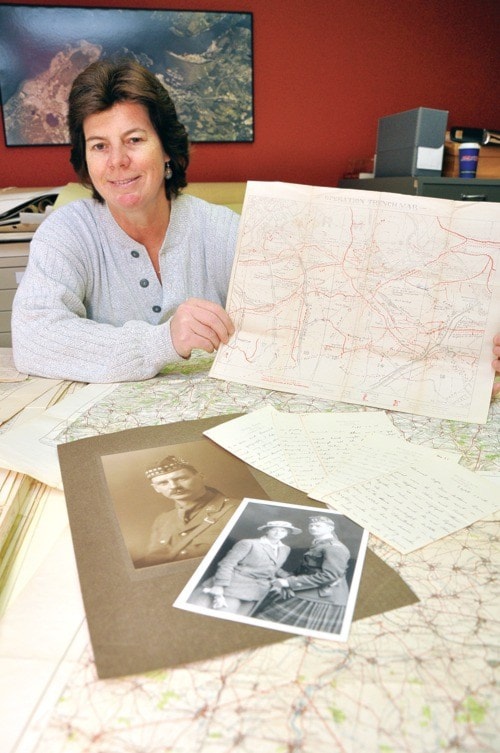Hidden inside the fonds at the Nanaimo Community Archives are the last remaining possessions of Alice and Arthur Leighton. From the faded photographs to the handwritten letters and meticulously detailed battlefield maps, they tell the story of two lovers torn apart and brought back together during the First World War.
Arthur was born in England on Jan. 5, 1880. His parents were school teachers and he was educated in Cambridge and Bristol. Eventually, Arthur immigrated to Canada, finding work as a farmhand in Manitoba. Alice, born Jan. 10, 1887, in Brittania, Ont., was the daughter of a prestigious farmer.
They met shortly after 1904 when Arthur came to work on the Wright Farm. Arthur had just returned from fighting in the Boer War in South Africa. He studied law at the University of Manitoba and was called to the bar in 1908, the same year he and Alice were wed in Ontario.
It was in 1912 that Alice and Arthur Leighton came to Nanaimo. Arthur, who had been practising law in Minnedosa, Ont., became a senior partner of the Leighton, Meakin & Weir law firm. He became known in the community for his cricket playing abilities and, in addition to being a member of the Nanaimo Cricket Club, was on the B.C. all-star cricket team.
Everything changed in 1915 when Arthur enlisted in 2nd Canadian Infantry Brigade as a commissioned lieutenant (and later promoted to captain). Soon after, Arthur and his men found themselves involved in trench warfare in France, and it wasn’t long before the ink began to flow.
“My darling heart,
I wonder where you are and what you are doing, somehow when one is traveling, time seems very long,” reads one letter, from Arthur to Alice. “It seems like a week instead of only two days since I left you, and yet your sweet smiling face is as vivid in my mind as if I were still looking from the train at Vancouver. You are a brave little girl, dearie, and so are the others who are being left behind...”
Alice’s reply came nearly a month later, dated April 25, 1916;
“Dearie Heart,
I have just got your dear letter and it is so sweet to have you talking to me again. I too can still see your face smiling at me till the train curved away and hid you. I think that beautiful shiny morning was sent specially so we could give you a happy send off and I think we were just as elated here and it kept us from being too lonesy [sic]…”
Eager to bridge the distance between herself and her loved one, Alice booked passage aboard the S.S. New Amsterdam to England later in 1916.
After a brief reunion with Arthur, she began work with the Ministry of Pensions, and later volunteered at St. Dunstan’s Hostel for Blind Soldiers and Sailors.
The two would be together again for a brief period, when Arthur sustained a knee injury from a shell blast.
However, they didn’t return home to Nanaimo until 1919, when they settled in Departure Bay. Arthur returned to his law practice and Alice became involved in many charitable societies.
In 1922, Alice became the second woman in Nanaimo to be elected to the office of school trustee, beating out Mayor Busby and ex-alderman G.W. Ferguson.
Arthur and Alice never had children, and passed away in August 1953, and July 1957, respectively. They are buried together in the Nanaimo Cemetery.
Christine Meutzner, manager of the Nanaimo Archives, said the Leighton collection, which was pieced together from their Hammond Bay Road home after their deaths, is historically significant.
“The Leighton collection is the most complete First World War collection we have, and it’s especially valuable because it includes his wife’s writings,” she said. “It’s the whole story from the husband/soldier’s perspective, the wife’s perspective, to what women did for volunteering work during the war.”
“It’s a very comprehensive collection, and it’s also very moving.”
The collection contains several of Capt. Leighton’s battlefield maps of Europe, drawn in meticulous detail, giving viewers an eerie reminder of what yesterday’s soldiers had to endure.
“What’s really cool about these maps is how ‘to scale’ they are when there was no aircraft yet, it’s all done by hand with no overhead visual to go by,” said archives assistant Teri Smith.
Meutzner added that the collection, and others like it, help make the wars of our past relatable to today’s society.
“We tend to think of it as something that happened so very far from here but it really didn’t, it affected people here,” she said. “The hopes, the aspirations, the expectations, the sadness – all of that hit home right here in Nanaimo. I think it’s easy to forget that.”
